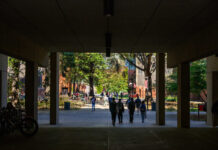In fact, their room in Louisville Hall is unique to campus. Roeder and Hartman live in UofL’s first green room, a concept room the university is using to determine what works and what doesn’t in sustainable housing.
Designed last spring by students in a sustainable architecture course at the request of Russ Barnett, director of research and development for the Kentucky Institute for the Environment and Sustainable Development, the room became reality through a $5,000 grant from Blaine Hudson, dean of the College of Arts and Sciences.
It was a strong collaboration between faculty, staff and students, said Jonathan Johnson, associate director of housing and residence life.
On Oct. 15, Roeder, Barnett and Johnson gave local media a tour of the 241-square-foot room.
The clay wall, Roeder explained, helps insulate the room. It also is more easily cleaned than a painted wall and helps repel dust, which makes the air cleaner.
Bamboo is more sustainable in its growing cycle than wood, Barnett noted, because it is a grass that will grown back relatively quickly when cut, and it is better for the internal environment than traditional carpet or vinyl because it does not emit gasses.
Those features, said Roeder, are probably the most noticeable differences between her current room and the one she had last year in Unitas Hall. But there are others that make the room sustainable.
A large window floods the room with natural light. A ceiling fan helps with heating and cooling; and a low-flow shower head and toilet and an aerator on the faucet have cut water use by 50 percent.
Roeder, the housing and residence life green committee chair, said she was selected to live in the green room because she had an interest and passion for sustainable living.
UofL’s plan is to get feedback from her and Hartman, as well as from maintenance staff, about the practicality of the sustainable elements in the room.
Eventually, Johnson said, housing and residence life would like to provide more opportunities for students to live sustainably.
This is a good start, he said.
The best part about living in the room, Roeder said, is being able to feel good about daily living activities that are more sustainable than traditional dorm living.
I’m excited about that.


























